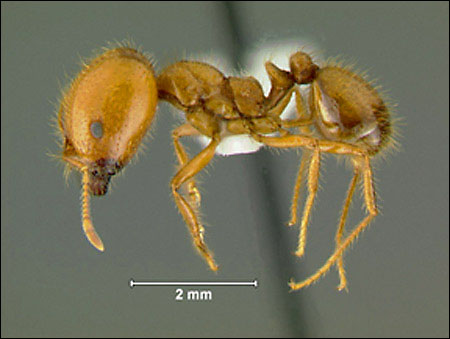Ants are surprisingly ancient, arising 140-168 million years ago
Insects flourished with the rise of flowering plants
Ants are considerably older than previously believed, having originated 140 million to 168 million years ago, according to new Harvard University research that is the cover story in this week’s issue of the journal Science. But these resilient insects, now found in terrestrial ecosystems the world over, apparently only began to diversify about 100 million years ago in concert with the flowering plants, Harvard scientists say.
Led by Corrie S. Moreau and Naomi E. Pierce, the researchers reconstructed the ant family tree using DNA sequencing of six genes from 139 representative ant genera, encompassing 19 of 20 ant subfamilies around the world.

Moreau, Pierce, and colleagues used a “molecular clock” calibrated with 43 fossils distributed throughout the ant family tree to date key events in the evolution of ants, providing a well-supported estimate for the age of modern lineages. Their conclusion that modern-day ants arose 140 million to 168 million years ago pushes back the origin of ants at least 40 million years earlier than had previously been believed based on estimates from the fossil record.

“We estimate that ant diversification took off approximately 100 million years ago, along with the rise of flowering plants, the angiosperms,” says Pierce, the Sidney A. and John H. Hessel Professor of Biology in Harvard’s Museum of Comparative Zoology. “Our results support the hypothesis that ants were able to capitalize on the ecological opportunities provided by flowering plants and the herbivorous insects that co-evolved with them. These plants provided ants with new habitats both in the forest canopy and in the more complex leaf litter on the forest floor, and the herbivorous insects that evolved alongside flowering plants provided food for ants.”
The Harvard researchers found that the poorly known ant subfamily Leptanillinae is the most ancient, followed by two broad groups known as the poneroids (e.g., predatory hunting ants) and the formicoids (e.g., more familiar species such as pavement ants and carpenter ants). Moreau, Pierce, and their colleagues also found that most individual ant subfamilies are more ancient than had been previously proposed, and that the modified stingers found in some ants arose independently at two different points in the course of ant evolution, in the subfamilies Formicinae and Dolichoderinae.
Moreau and Pierce’s co-authors on the Science paper are Charles D. Bell at Florida State University and Roger Vila and S. Bruce Archibald in Harvard’s Museum of Comparative Zoology. The research was funded by the National Science Foundation and the Green Fund.




